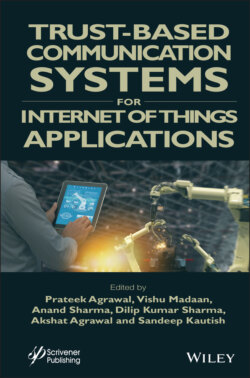Читать книгу Trust-Based Communication Systems for Internet of Things Applications - Группа авторов - Страница 23
2
Blockchain in IoT and Limitations
ОглавлениеVishal Walia1, Vishu Madaan1, Prateek Agrawal1,2*, Anand Mohan3, Charu Gupta4, Anand Sharma5 and Akshat Agrawal6
1 School of Computer Science Engineering, Lovely Professional University, Punjab, India
2 University of Klagenfurt, Austria, Europe
3 P.G. Department of Physics, C.M Science College, L. N. Mithila University, Darbhanga, Bihar, India
4 Department of Computer Science Engineering, Bhagwan Parshuram Institute of Technology, GGS-Indraprastha University, New Delhi, India
5 Modi University of Science & Technology, Laxmangarh, Rajasthan, India
6 Amity University, Haryana, India
Abstract
Blockchain (BC), which is for encryption and confidentiality purposes in the Internet of the Things (IoT), was gradually taken as a key in the cryptocurrency Bitcoin. BCs are therefore computer-intensive and have packet prioritization latency and limitations that are not appropriate for most IoT applications. This chapter introduces a streamlined BC-based IoT architecture which completely eliminates traditional BC’s overhead costs while retaining most of its security and privacy advantages. In order to maximize the power consumption, IoT machines gain from the BC-like, eternal secret leader. High resource machines build a lay infrastructure to enforce a centralized BC, which is freely open and guarantees end-to-end protection and confidentiality. To that testing period, the planned framework uses mutual trust. We look at our solution in an intelligent home environment as well as a research paper for wider IoT applications. In order to provide protection for IoT applications, a quality infrastructure assessment under credible threat template emphasizes its usefulness.
Keywords: Internet of Things, security, privacy, blockchain
